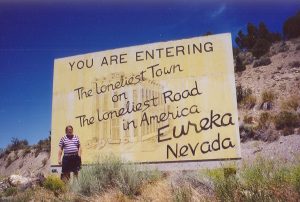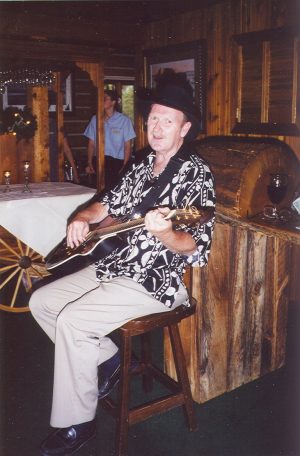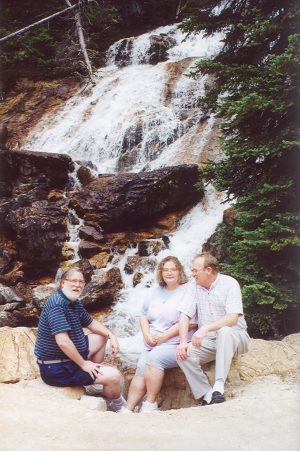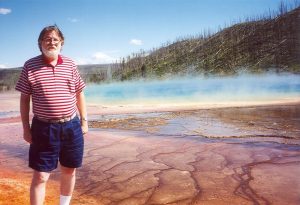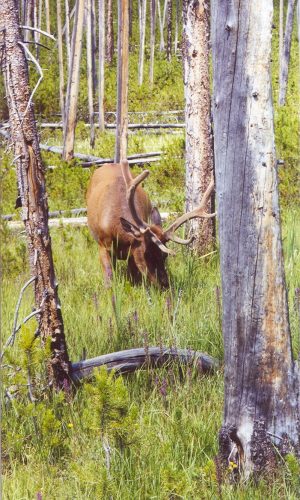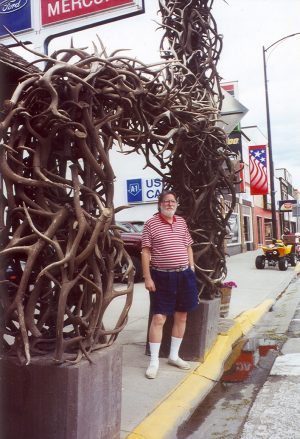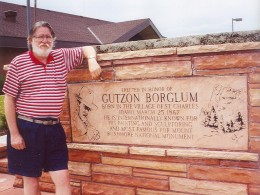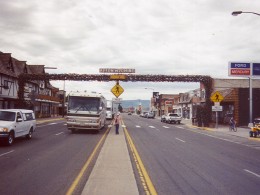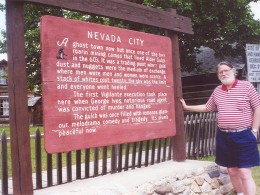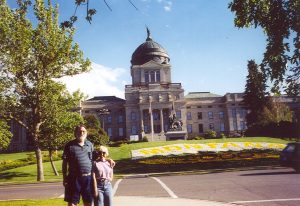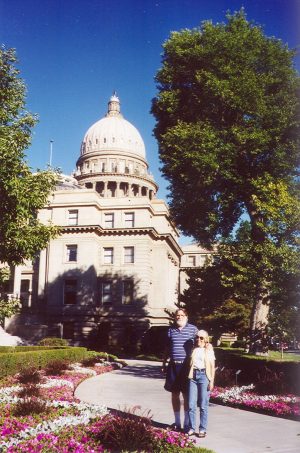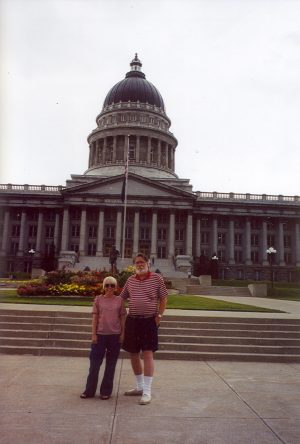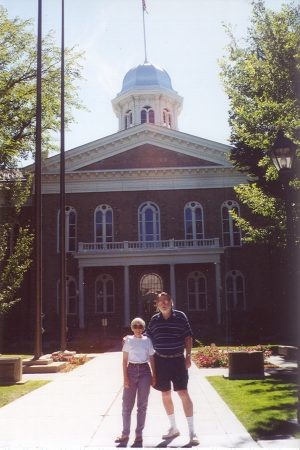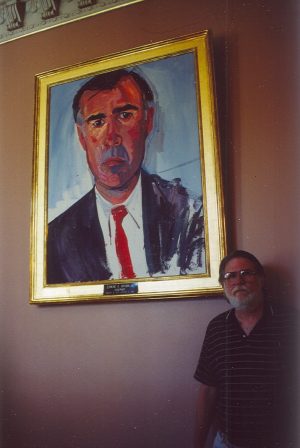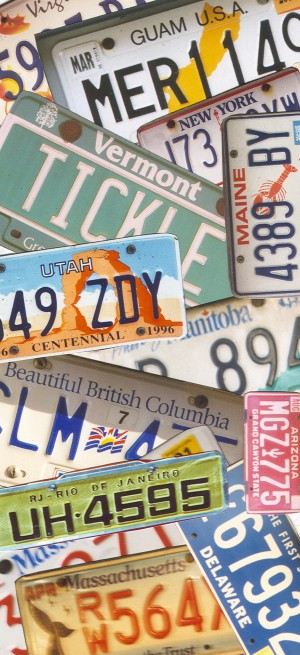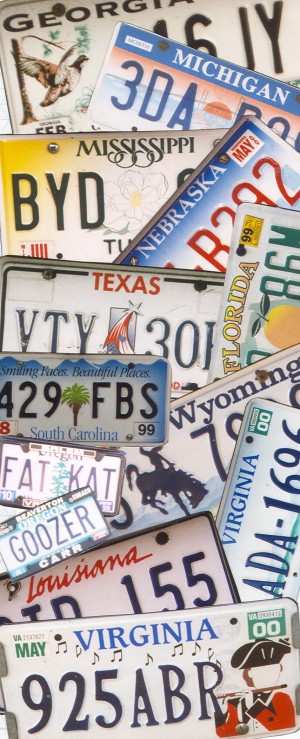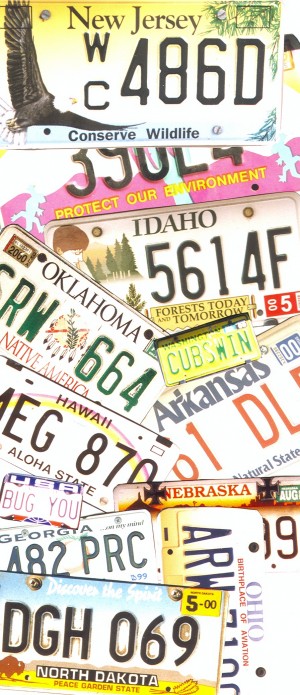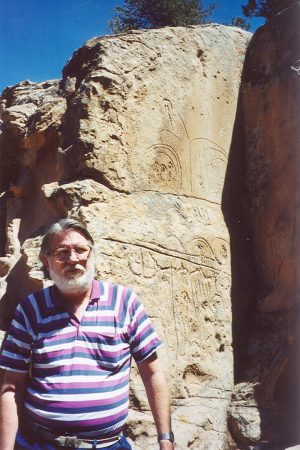We figured six, maybe seven states before the trip was over: Oregon, Idaho, Montana, Utah!, Nevada, California, and maybe Wyoming if we took a little jog to the east through Yellowstone. The big reason for the trip was simply that we really needed a trip, going a bit stir crazy out here in the trailer. But we also planned to pass through the Bay Area and possibly scout out a good parking place for when we finally are ready to pull the beast out of Oregon.
And I wanted to see my old buddy from high school, Chris Kingsley, and his wife, Lennie, in Hamilton, Montana, in the middle of the reputedly beautiful—according to Chris—Bitterroot Valley. A few months earlier Calvin, our other best friend from high school days, had bent over to pick something up off the floor … and just kept going down and never got up again. A massive heart attack, followed by a few days in a brain-dead coma. It had been over ten years since I last saw him, and now the chance would never come again. Makes you think.
If Hamilton or the Bitterroot Valley sound at all familiar to you, it’s probably because, as I write this, the whole damn valley is on fire and Hamilton is smack in the middle of it. It is very odd for me to think back on being there just a few weeks ago—and it was as beautiful as Chris promised—and know it may be decades or a century before it’s that beautiful again. Much worse for Chris and Lennie, of course, watching it being consumed all around them. A bad shift in the wind could sweep the whole little town into a holocaust. As it is, the smoke is so bad they can’t see across the street. And the forecast is for more dry lightning and no rain.
* * *
They showed us the sights of western Montana, taking us over back roads we’d never have explored without a guide. Beautiful mountains, lakes, waterfalls … but there’s no point in trying to describe all that. Buy a postcard. My most vivid impression is of Butte, the only town in America, maybe in the world, built on the rim of a toilet bowl. It’s the remains of an open-pit mine (copper?), and it looks about a mile across and at least that deep. It’s full of red water and scored with the spiral lines of roads the gigantic trucks used to drive to the bottom. There were still some of those trucks driving around the edges of the bowl, looking like Tonka toys. I looked for the Ty-D-Bol man in his little boat, but I think he got discouraged and paddled away; that damn bowl was really stained. One day somebody’s going to find the handle and flush Butte.
Before going there all I knew about Butte had to do with the FBI. When an FBI agent really screwed up (say, by making a cutting remark about J. Edgar Hoover’s new dress), the Director was said to have banished him to Butte, Montana. The idiot had never been to Butte; he just picked it out as a funny-sounding place in the boonies that was probably an awful place to be. Actually, from looking around the old part of town, it wasn’t really all that bad a place, aside from the mine and the cold weather. We saw a lot of old Victorian houses, some mansions, that would be lovely with a new coat of paint. But as they say in real estate: location cubed. I’d happily live in one of those houses if it was moved to, say, San Francisco.
* * *
Chris has written a short musical called LAB RATS. It’s got 12 original songs dealing with scientific discoveries and the scientific method, and I think it would make a really great hour-long show on PBS or Discovery or Nickelodeon. Like this one about the discovery of the structure of DNA:
At Cambridge in England their work had its start
Where formal and stuffy’s been raised to an art.
Some tried to dissuade them, but they had such heart
They kept right on trying ‘cause they were so smart.CHORUS: They were Watson and Crick, Watson and Crick,
Studied our genes to see what makes us tick
The prize only goes to the clever and quick
CRICK: That’s us, Crick and Watson,
WATSON: That’s Watson and Crick.
Or this, concerning Isaac Newton:
He had a crazy notion
There were laws that govern motion
With a scientist’s devotion
He set out to find out how.
He found for every action
You can’t get no satisfaction
And your shoes can’t get no traction
If there’s no reaction now.
Neat, huh? So far it has only been performed by the students at the school where Chris teaches. If anyone out there has any ideas how to market it, get it produced…?
* * *
We did take that jog into Wyoming, and were glad we did. Lots of fun stuff in Wyoming. There’s Yellowstone, of course, but I’m daunted by the idea of writing much about Yellowstone. There have been so many pictures, so many descriptions, so many rapturous odes … and not a one of them comes anywhere near the awesome truth. So don’t buy a postcard, you simply have to go there to see and feel it. You’re walking on unstable ground in Yellowstone, and seeing colors you’ve never seen before. I think you’d have to travel to one of the Jovian moons—Io, Europa, Ganymede—to see a landscape so alien.
So, no overheated descriptions, but I can offer some impressions and reactions.
The first thing we saw after paying the … I think it was $20 admission fee, was a tangle of cars parked on either side of the road. Lots of people had left their cars and were looking at an elk standing no more than twenty feet away. We stopped, too. Everybody had a camera of one kind or another. We did, too. So we all stood there and filmed an elk placidly eating green shoots, and that elk was totally oblivious to us. He actually moved a little closer to the group of people as he grazed. We might have been trees, or fire plugs. After a while we drove on, and the elk was still the center of attention.
Now, I’m not going to complain about American tourists spoiling the great, rugged wilderness. After all, I was one of those tourists, so I don’t see where I’ve got the right. Hikers, backpackers, people who get off the paved road, they have a right to bitch about it, not that it will do any good. Traffic jams at places like Yellowstone, Yosemite, the Grand Canyon, that’s just the way it is and we might as well get used to it. If there were no paved roads or wooden walkways out to the bubbling mud pots and steaming blue pools and geysers … well, people like me would be unable to see even the quasi-wilderness that’s now accessible to us.
But it is a bit weird. For the wildlife it’s like a zoo without cages. The animals are so used to people they don’t even see us anymore. And every now and then a tourist or two gets out to photograph a bear at close range …
We didn’t see any bear, or buffalo, or moose. In fact, other than chipmunks we didn’t see any wildlife but that elk. Nor did we encounter any actual traffic jams … and when we got to the visitors facilities near the center of the park I couldn’t figure out just why we didn’t. The place was jammed, parking lots filled, people everywhere, and they’d all come in over the same two-lane blacktop roads we had just traveled. If they all decided to leave at once there would be a crush for miles. There were at least three huge buildings that had that ‘30s WPA look to them, like Timberline on Mount Hood. And just a few hundred yards away was Old Faithful.
This time I really had to laugh at human folly. Old Faithful is not as faithful as it once was since some earthquakes some years back, but it’s still the most regular geyser in the park. So it had been completely circled with concrete sidewalks on which were concentric rings of benches to watch the show. When we got there the next eruption was due in another 40 minutes, according to the Old Faithful Clock in the lodge. Or it could be more than an hour. Something about the crowds that were even now settling into their places just turned me off. We decided to get on the road again. Maybe next time.
It all reminded me of an old Stan Freberg radio bit concerning Las Vegas one-upmanship, where two casinos, the El Sodom and the Rancho Gomorrah, each tried to top the other. The final act was: “Ladies and gentlemen, the Rancho Gomorrah proudly presents, for one night only … the Hydrogen Bomb!” But Old Faithful is as tame as everything else in the park. At the most, some people might get drenched in hot water.
* * *
Not far out of the Yellowstone/Teton park complex we came to Jackson (Hole). I write it that way because there seems to be a bit of civic schizophrenia at work in the town, and on our maps. The town is bustling and prosperous, but it has a Disneyland look to it, full of lights and expensive stores that were probably new but had put on that Old West look for the tourists. And there are plenty of tourists. Jackson (Hole) has turned itself into a high-priced year-round recreation area. Skiing in the winter, dude ranching, kayaking, and river rafting in the summer. My guess about the name is that at least some of the city leaders thought that Jackson Hole was not a great name for a town. So all over were signs saying, simply, Jackson. If you ask me, though, the old name is best. I mean, it really sounds western, you know? Like Jumpoff Joe in Oregon, or Jackass Flats, Nevada.
There was a small park in the center of town that had what they called an antler arch over each entrance. An antler arch is a rickety-looking structure built of interlocking deer or elk horns. There must have been a thousand in each arch. Were thes all antlers taken off deer killed by hunters, or were they picked up off the ground where the bucks shed them? I don’t know. But not far down the road, in Afton, Wyoming, there was what was alleged to be the “Largest Antler Arch in the World.” I don’t doubt it. The thing stretched over six lanes of street. I guess everybody wants to be famous for something.
* * *
Two things we saw over and over on the trip that pretty much astonished us: motorcycles and bicycles.
The motorcycles were almost always Harleys, and they weren’t being driven by any outlaw biker gangs. Most of them were people our age or older. And they weren’t choppers, either. They were things of beauty, these bikes, gleaming chrome and gaudy paint jobs. All of them had hard-sided panniers and luggage carriers, some with sidecars, some towing tiny little Harley trailers. No kidding. These bikes were equipped with intercoms, compact disk players, two-way radios, and for all I know, collapsible wide-screen TVs, microwaves, and trash compactors. We figured these were slightly more adventurous versions of the little old gray-haired people you see driving three or four hundred thousand dollar bus conversions or pulling fifth wheels. Roughing it, you know?
Then there were the cyclists. They were all over Yellowstone, all over the wide open country in Montana and Idaho, no trek too long, no slope too steep. Thousands of them. It made me tired just to come to the top of a long upgrade and see some hard-pedaling maniac working his or her way up the last few yards to the top. Sure, the ride down was going to be exhilarating, but how the hell did they ever make it up there? Lee and I have just gotten bicycles to ride around Sauvie Island for exercise, and a ten-mile jaunt over land level as a pool table leaves us with weak legs and sore butts. I imagine we’ll toughen up a bit as time goes by, but on my best day, when I was fifteen or sixteen, I could never have made it up those slopes. My hat is off to them.
* * *
We are collecting state capitals. That is, we plan to get our picture taken standing front of every state capital building in the U.S, and maybe Canada. Before this trip we had only collected three: Olympia, Washington; Salem, Oregon; and Baton Rouge, Louisiana. Before this trip was over we had added five more. (Next month we should be able to add Honolulu, Hawaii, to the list.)
Boise, Idaho, and Helena, Montana were both quite nice, but fairly standard domed edifices, about the right size for states with such small populations, in medium-sized towns as so many capitals are. But the one in Salt Lake City, Utah!, was all out of proportion. Not that it wasn’t attractive—it was—but it was huge. I don’t know the exact population of Utah!, but it can’t be very high.
- Boise, ID
- Salt Lake City, UT!
I think there must be something about Utah! that leads its citizens to build monuments. There are the Mormons, of course, with their imposing Temple and Tabernacle. But there is the huge Cathedral of the Madeleine not far away, and across from that an imposing Episcopal church. We wondered if the Catholics felt they had to put on a big show in what is, essentially, a one-industry town, that industry being Latter-Day Saints.
In the Cathedral I checked out the Stations of the Cross, like I always do. In this one, they were surprisingly modern-looking. I doubted they were more than twenty years old, and I was right. A pamphlet told us they had been painted in 1992 by Utah! artist Roger Wilson, which makes them about 80 years younger than the building.
Can’t go to Salt Lake without visiting the Temple grounds. (I wonder, do you have to show a membership card or something to get in the building itself? I understand only Mormons are permitted inside.) So we strolled the lovely grounds, which would have been even lovelier if they hadn’t been infested by so goddam many Mormons. It wasn’t their Mormonism I objected to, but their persistent evangelism. Every time you turned around there was another bright-faced youngster wanting to have a sincere talk with you. I also couldn’t help noticing that at least half of these kids were black or brown. I felt a point was being made: “See? See? Maybe it was only in the 1970s that the elders had the revelation that black people could be Mormons, but we’ve got plenty of them now.” We got out of there pretty fast, before they could start grabbing at our clothes or maybe drugging us and taking us to the catacombs under the Temple for who-knows-what kind of heathen smiley-face brainwashing?
By the way, I advise avoiding Salt Lake City, if possible, at least until 2003, when the Olympics are over. They are re-building their freeway system for the Games, and it is a terrible mess. Even after that, if they don’t do something about their system of naming streets, the lot of the lone tourist will still be desperate. I never did figure it out. I got lost three or four times, and I never get lost. Word to the wise.
Wyoming’s capital in Casper is way the hell and gone over in the southeastern corner of the state. We’ll have to catch it next time.
Then there was Carson City, Nevada, where you visit the capitol in stages. There is a small, century-old building with barely a hint of the grandeur we had been seeing. Your standard capitol edifice has a big dome and houses the House or Assembly on one side and the Senate on the other. Somewhere in the building will be the Governor’s office and the State Supreme Court. Not Nevada. They apparently outgrew that arrangement and now the old, restored building is home to just the Executive branch. Next to it, and looking sort of like a new library building on a college campus, is a separate building housing the Supreme Court, and not far from that is the Legislative Building. Its style is sort of ‘70s Shopping Mall. Very little governmental-looking about it. I can’t decide if that’s good or bad. But it’s sure different.
Sacramento, California, took the prize for Most Improved. It is huge, possibly bigger than the one in Austin, Texas. (Though not higher; Texans deliberately built their capitol to be a few feet higher than the one in D.C., prompting Congress to make a law decreeing a height limit for future capitols. They didn’t go so far as to force Texas to tear down the impudent structure, however, and it stands as the highest capital dome in the nation.)
When I lived in California I recall public debate about what to do with the old building. Engineers had said that only a moderate quake would turn it to rubble, and it was going to be very expensive to restore and upgrade it. That’s what they did, though, and the results are impressive. The whole first floor is basically a museum. There are offices dressed to look as they had in the 1900s, or the ‘20s, based on old photographs. They went so far as to not pretty it up too much; twice I saw electrical cords screwed into hanging light fixtures, just like it was in the old photos. As in so many old buildings (like our recent home in the Monte Carlo) there were not enough outlets to go around, so they improvised this ugly expedient.
Speaking of ugly, there was a room devoted to the Governor’s Mansion, and it seems they are planning to build another one. During Reagan’s term a new mansion was authorized because the old one was apparently in bad shape. They built some incredible monstrosity —there were no pictures of it in the exhibit, as if they just wanted to forget the whole episode, but I remember it reminded me of a Safeway with a brick front instead of glass. It wasn’t finished in time for Ron and Nancy to move in … and when Jerry Brown came along he took one look at it and never set foot in it again. He lived in an apartment during his term.
As is common in these places, the capitol walls were lined with portraits of all past Governors. Placed prominently were some of the most famous: Reagan and Jerry Brown and Earl Warren. (Also Henry Haight of Haight-Ashbury fame.) I wanted to sneak back in the middle of the night and replace Reagan’s with that old cowboy poster showing him smiling and pointing a gun at you, captioned “Thanks for the votes, suckers!” As usual, Brown was out of step with the rest. He had picked an artist with a decidedly more modern approach to portraiture. It wasn’t quite a Picasso, both eyes weren’t on one side of his head, but the artist didn’t like fine brush strokes. He laid it on thick, in primary colors. The result was a little like a cartoon. Well, so was Jerry, I guess.
Then at some point in our explorations, the place suddenly turned into a high school from the 1960s, or a hospital. Bland greenish walls, merciless overhead fluorescent lights. There was an endless series of display cases set into the walls where, at Nederland High School, my alma mater, we would have displayed football trophies or exhibits from the 4H club. These displays were from the umpty-ump counties of the Golden State, and looked like they’d been put together by high school students, and also as if they needed dusting. It was a horrible space, bland and dehumanizing.
Outside, the secret was revealed. Grafted onto the back of the grand old building like Siamese twins of dissimilar species was a concrete excrescence that would have looked right at home in the workers’ paradise of Albania. This addition, twice the size of the old building, was obviously where all the work got done. Do bureaucrats not mind working in such awful places? If so, why didn’t they put it underground, where the rest of us won’t have to look at it? The only good news was that the capitol grounds were so spectacular, with huge trees from all over the world and flower beds and other things to look at, that one’s eyes could sometimes slide right over the ugly blockhouse.
* * *
You may be wondering why I’ve been spelling Utah! With an exclamation point. (Or you may not be. Either way, I’m about to tell you.) It’s the license plates.
Lee and I have been collecting pictures of license plates. Just for something to do, like the game we used to play on family trips when I was young, see who can spot the most out-of-state plates. We got all 50 and Guam (!) in about two months, around Portland. (It took a long time to find West Virginia, which says, “Wild, Wonderful”.) We also got 7 Canadian Provinces. The plate for the Northwest Territories is shaped like a polar bear, I kid you not.
The majority of states now sell special plates of one sort or another. Sometimes they are in support of various causes. Conservation is a big one. Idaho has plates with an elk, and one with a blue jay. Florida has at least six different types; you can get one with a manatee, or a panther, or one with an abstract pattern in aid of “The Arts.” The one we photographed read BRKA LG. (Break a leg, get it?) A lot of them have gooey, feel-good mottoes on them. South Carolina’s says “Smiling Faces, Beautiful Places.” Yuck. But then South Dakota’s says “Great Faces, Great Places.” I guess if great minds think alike, trite ones do, too.
There was an effort a few years back to put “The Friendship State” on Texas plates. Without a doubt this was proposed by some of the millions of Yankees who have moved south in recent decades, like those Kennebunkport Karpetbaggers, the Bush family. Texas has always been, is, and always will be, “The Lone Star State,” and it says that on the plates.
Utah! has three types of plates. One is sort of pre-commemorating the 2002 Winter Olympics. Another shows a lovely orange natural stone arch of the kind found in Bryce Canyon and Zion, in southern Utah!, and is one of the prettiest license plates around. The third proclaims “Utah!” in big red letters. Well, actually, it says “Ski Utah!” at the top and “The Greatest Snow On Earth” at the bottom, but the SKI is in narrow blue letters so you might not even notice it the first time you see it. I didn’t, and thus decided that Utah! had become the second state to incorporate an exclamation point. Oklahoma! was the first, courtesy of Rodgers and Hammerstein.
A state that spells itself Utah! ought to have a rousing state song, don’t you think? I’m sure they’ve got a song, but I’d be willing to bet that, like most state songs, it’s a dreary thing. (The one I learned in school was “Texas, Our Texas.” Gag me and bag me.) But the other choices were “The Eyes of Texas Are Upon You,” which I always thought was kind of creepy, and “The Yellow Rose of Texas,” which is supposedly about the mulatto whore Santa Ana was bedded down with when Sam Houston whipped his murderin’ butt at the Battle of San Jacinto. I’d anticipate objections to naming it the state song. Too bad, because my own choice would be “Texas Has a Whorehouse In It!” from Best Little Whorehouse. I wonder why so many songs about Texas have whores in them?
Anyway, I’ve started writing Utah! a new state song. It should be sung to the tune of “Oklahoma!”, and it begins like this:
Uuuuuuuuuuuuuuuu-tah! Utah!
Where the smiles keep spreadin’ ‘cross your face!
And the Mormons sung
When Brigham Young
Stood and hollered out “This is the place!”
Then da-dum da-dum da-dum “Great Salt Lake,”
and something something something “Promontory Point.”
I haven’t figured out how to work in “Olympic bribery scandal” yet. Does anybody have a good rhyme for “polygamy?”
* * *
U.S. Highway 50 is called “The Loneliest Road in America.” We decided to go that way because I’d already done I-80, and because we try to stay off the Interstates when possible. Stephen King, on one of his rare forays out of the State o’ Maine, set a novel called Desperation in a fictional town of that name, on 50.
I already told you the price we paid in gasoline for going that way. I suspect it would have been cheaper on I-80. It was pretty country (“Nice place to visit…”), and we went to a site with Indian petroglyphs carved in the rocks. It really was lonely, though. Not many cars going in either direction.
There was a little town of Eureka, which billed itself as “The Loneliest Town On the Loneliest Road in America!” I guess everybody wants to be famous for something.
Then, on our way out of Austin, Nevada, Lee got pulled over by a State Smokey. He was a little pipsqueak in a new Blazer, and we just know he was lurking behind an abandoned building (about all there was in Austin was abandoned buildings) looking for out-of-state plates. He wrote Lee up for doing 40 in a 25 mph zone, after first spouting that crap about how he was “going easy” on her, since she was really going 45, and that would qualify as a much worse offense. Sure. I’ve heard that story every time I’ve been pulled over for thirty years.
You think Reno or Vegas is pretty efficient at taking your money? Try Austin, Nevada. Between the highway robbery of $2.15/gallon gas and the speed trap, little ol’ Austin can take you to the cleaners faster than any Vegas one-armed bandit.
* * *
Many times during the trip one of us would look out the window, take a deep breath of the bracing country air, and say something like, “Man, this is beautiful country! Look at that picture postcard farm there, with the white fences and big old barn!” “Yes,” the other would say. “It’s gorgeous!” And then, “The herds of black Angus, and Guernsey cows, horses, even llamas!” “Prettiest country I’ve ever seen,” the other would agree. Then there would be a short pause, and one of us would say, “So, how long do you think you could live here without going nuts?” And the other would reply, “In three days, I’d be as buggy as a flophouse mattress.”
Nice place to visit, wouldn’t want to live there. I guess there’s people who enjoy open spaces and isolation, and those who can only pass through it and appreciate it.
Isolation is not what it used to be, though. The folks of River City, Iowa, just had the railroad, the Wells Fargo Wagon, and the occasional telegraphic message to keep them in contact with the outside world. These days, small-town or farm or ranch people often have a giant satellite dish rusting in the backyard with the old Buicks and International Harvesters… but the reason it’s rusting is that it’s been replaced by the new, pizza-pan dishes that bring in as many as 500 television channels. Some of these country folks get more TV than people in big cities. And you can bet that Farmer Bob uses a computer to run his operation, and that computer is wired into the Internet. Did you know that ranchers these days put collars on their cattle so they can keep track of them with the Global Positioning Satellite network? When it’s time to round up them dogies, he just jumps on his cayuse, calls up the GPS on his saddletop computer, links up on his cell phone, and knows the position of the herd to within a couple of feet.
www.hoopee-ti-yi-yo.com!
I’ll probably never understand those people who elect to stay in these small towns. But the answer to the question “Why would anybody live all the way out here?” can have a pretty simple answer: Because they don’t have any choice.
July 21, 2000
Sauvie Island, Oregon

